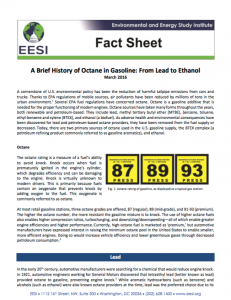Full Title: A Brief History of Octane in Gasoline: From Lead to Ethanol
Author(s): Jessie Stolark
Publisher(s): Environmental and Energy Study Institute
Publication Date: March 1, 2016
Full Text: Download Resource
Description (excerpt):
A cornerstone of U.S. environmental policy has been the reduction of harmful tailpipe emissions from cars and trucks. Thanks to EPA regulations of mobile sources, air pollutants have been reduced by millions of tons in the urban environment.1 Several EPA fuel regulations have concerned octane. Octane is a gasoline additive that is needed for the proper functioning of modern engines. Octane sources have taken many forms throughout the years, both renewable and petroleum-based. They include lead, methyl tertiary butyl ether (MTBE), benzene, toluene, ethyl-benzene and xylene (BTEX), and ethanol (a biofuel). As adverse health and environmental consequences have been discovered for lead and petroleum-based octane providers, they have been removed from the fuel supply or decreased. Today, there are two primary sources of octane used in the U.S. gasoline supply, the BTEX complex (a petroleum refining product commonly referred to as gasoline aromatics), and ethanol.
